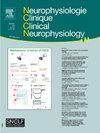纤维肌痛患者高频重复运动皮质经颅磁刺激缓解疼痛的预测因素研究
IF 2.4
4区 医学
Q2 CLINICAL NEUROLOGY
Neurophysiologie Clinique/Clinical Neurophysiology
Pub Date : 2025-10-04
DOI:10.1016/j.neucli.2025.103109
引用次数: 0
摘要
目的探讨纤维肌痛患者对初级运动皮质高频重复经颅磁刺激(M1 HF-rTMS)临床反应的基线预测因素。材料和方法我们对32名纤维肌痛女性患者进行了二次分析,这些患者来自一项随机、双盲、假对照的国际多中心试验,注册于clinicaltrials.gov (NCT03658694)。参与者在初级运动皮层(M1)接受活跃或高频rtms治疗。收集和分析基线人口统计数据、心理评估(医院焦虑和抑郁量表、简短疼痛量表、纤维肌痛影响问卷、多伦多述情障碍量表和内感受问卷)、心理物理测量(条理性疼痛调节)和脑结构MRI变量。应答者被定义为治疗后8周在数值评定量表上疼痛减轻≥50%的患者。基线变量与反应之间的关联分析使用Wilcoxon秩和检验、卡方检验和适当的逻辑回归。结果治疗期结束时,活跃M1 HF-rTMS组32名参与者中有15名(47%)和假手术组30名参与者中有7名(23%)的疼痛减轻≥50%。基线人口统计学、临床、心理、心理物理或神经影像学变量均未与M1 HF-rTMS的临床反应显著相关。尽管M1 HF-rTMS通过心理物理评估(热痛阈值)产生了显著的抗伤害感受效应,但这些效应并不能预测临床结果。结论纤维肌痛患者对M1 HF-rTMS治疗的反应没有明确的基线预测因素,强调了该疾病的异质性和复杂性。需要进一步的研究纳入更大的样本和更多的生物标志物,以建立M1 HF-rTMS治疗纤维肌痛的个性化预测策略。本文章由计算机程序翻译,如有差异,请以英文原文为准。
Investigation of predictors of pain relief with high-frequency repetitive motor cortex transcranial magnetic stimulation among people with fibromyalgia
Objectives
To identify baseline predictors of clinical response to the primary motor cortex high-frequency repetitive transcranial magnetic stimulation (M1 HF-rTMS) in patients with fibromyalgia.
Materials and methods
We performed a secondary analysis of 32 women with fibromyalgia from a randomized, double-blind, sham-controlled international multicenter trial registered at clinicaltrials.gov (NCT03658694). Enrolled participants received active or HF-rTMS-over the primary motor cortex (M1). Baseline demographic data, psychological assessments (Hospital Anxiety and Depression Scale, Brief Pain Inventory, Fibromyalgia Impact Questionnaire, Toronto Alexithymia Scale, and Interoception Questionnaire), psychophysical measures (Conditioned Pain Modulation), and structural brain MRI variables were collected and analyzed. Responders were defined as patients who achieved a ≥ 50 % reduction in pain on a numerical rating scale eight weeks after treatment. Associations between baseline variables and response were analyzed using Wilcoxon Rank Sum tests, chi-square tests, and logistic regression where appropriate.
Results
At the end of the treatment period, 15 out of 32 participants (47 %) in the active M1 HF-rTMS group and 7 out of 30 (23 %) in the sham group achieved ≥50 % reduction in pain. None of the baseline demographic, clinical, psychological, psychophysical, or neuroimaging variables evaluated were significantly associated with clinical response to M1 HF-rTMS. Although M1 HF-rTMS induced significant antinociceptive effects measured by psychophysical assessments (heat pain threshold), these effects did not predict clinical outcomes.
Conclusions
No clear baseline predictors of response to M1 HF-rTMS were identified in patients with fibromyalgia, emphasizing the heterogeneity and complexity of the disorder. Further research incorporating larger samples and additional biomarkers is necessary to establish individualized prediction strategies for M1 HF-rTMS therapy in fibromyalgia.
求助全文
通过发布文献求助,成功后即可免费获取论文全文。
去求助
来源期刊
CiteScore
5.20
自引率
3.30%
发文量
55
审稿时长
60 days
期刊介绍:
Neurophysiologie Clinique / Clinical Neurophysiology (NCCN) is the official organ of the French Society of Clinical Neurophysiology (SNCLF). This journal is published 6 times a year, and is aimed at an international readership, with articles written in English. These can take the form of original research papers, comprehensive review articles, viewpoints, short communications, technical notes, editorials or letters to the Editor. The theme is the neurophysiological investigation of central or peripheral nervous system or muscle in healthy humans or patients. The journal focuses on key areas of clinical neurophysiology: electro- or magneto-encephalography, evoked potentials of all modalities, electroneuromyography, sleep, pain, posture, balance, motor control, autonomic nervous system, cognition, invasive and non-invasive neuromodulation, signal processing, bio-engineering, functional imaging.

 求助内容:
求助内容: 应助结果提醒方式:
应助结果提醒方式:


